AFRICA & THE MIDDLE EAST
CAPE TOWN
Ever the innovator in food and drink, South Africa’s most progressive city is leading the country’s craft gin revolution, with local distillers infusing spirits with floral botanicals including indigenous fynbos and tea leaves. The Woodstock enclave is a hotspot for imaginative tastings and tours.
BEIRUT
Alcohol isn't widely consumed in the Middle East, but the capital of Lebanon is a hedonistic exception. Traditionally, the tipple of choice is arak – a clear spirit made from distilled wine and aniseed by many a home producer, then brought to the big city by bars such as Anise.

LEBANON
How to ask for an arak? Please baddi arak baladeh (Beiruti dialect includes a mix of Arabic, English and French!)
Signature spirit? Arak, mixed with water, ice, and sometimes a sprig of fresh mint
What to order with your arak? It’s likely you’ll get a dish of salted peanuts and/or a tumbler of carrots in salted lemon juice. If you are hungrier than that, order hummus and tabbouleh
Do: seek out arak flavoured with a drizzle of sharab al-toot, a syrup made from the mulberry crop every spring. Its sweetness tempers the burn of the spirit, which can reach 80 to 120 proof
 Beirut is renowned as a hedonistic city, and you won’t find much here to disprove this reputation. But to get a real sense of Lebanon’s drinking culture, start your initiation over the mountains in the Bekaa Valley.
Beirut is renowned as a hedonistic city, and you won’t find much here to disprove this reputation. But to get a real sense of Lebanon’s drinking culture, start your initiation over the mountains in the Bekaa Valley.
Unless you’re very unlucky, the day you visit the Bekaa will be gloriously bright. The Romans were the first to celebrate the Bekaa’s climate; the megalithic ruins of the ancient solar cult of Heliopolis (Sun City) still stand in the centre of the modern-day town of Baalbek. These days, however, there are certainly more grapes basking in the Bekaa sun than holiday-making UV devotionalists: the region is practically administered by militant group and Shia political party Hezbollah, which discourages immodest dress and, for that matter, drinking.
But within the vine-covered confines of the Valley’s wineries and distilleries, visitors quaff drink and guzzle food with an abandon that might make Epicurus blush. The wineries draw day-trippers from Beirut at weekends, who spend hours sampling Lebanese mezze (small plates) from heaving tables, and take full advantage of near-universal policies of open wine and arak.
In the early evening, revellers pile into cars to travel back to Beirut (make sure yours is a taxi), where the party continues in the bar districts of Mar Mikhaël and Hamra. Rounds of drinks are punctuated by doudou shots: vodka, a squeeze of lemon, a few shakes of Tabasco sauce, and an olive. Fair warning: like the Beiruti lifestyle, doudou shots are addictive.
The English word ‘alcohol’ is derived from the Arabic word al-kohl, meaning elixir or cure. Before leaving Beirut, raise a glass to those early Arab alchemists who first burned wine.
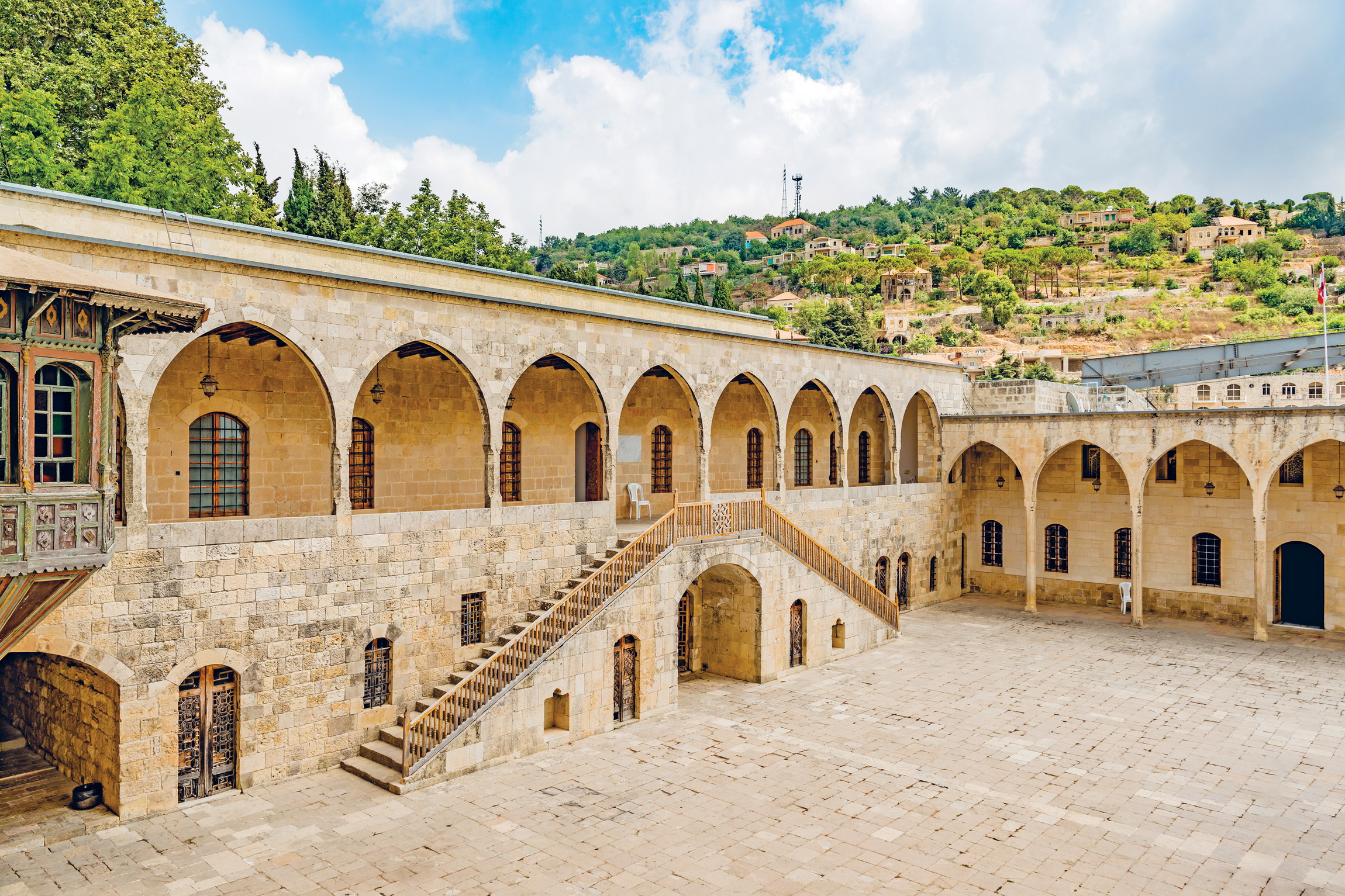
©JPRichard/Shutterstock
 BAR
BAR
ANISE
Mar Mikhaël, Beirut
www.facebook.com/AniseCorridorBar; +961 7097 7926
◆ Food
◆ Bar
◆ Transport
 In the middle of Beirut’s frenetic nightlife scene sits this cool cocktail bar resembling a James Bond movie, with suave white-jacketed barmen serving Hemingway Martinis. But Anise is also dedicated to Lebanon’s national drink, arak – a clear alcohol made from distilled wine and green aniseed, which is aged in stone amphoras and, when served, turns milky white as water is added.
In the middle of Beirut’s frenetic nightlife scene sits this cool cocktail bar resembling a James Bond movie, with suave white-jacketed barmen serving Hemingway Martinis. But Anise is also dedicated to Lebanon’s national drink, arak – a clear alcohol made from distilled wine and green aniseed, which is aged in stone amphoras and, when served, turns milky white as water is added.
It may look like pastis or raki, but this spirit is very different. Although there are some industrial producers, arak is essentially a home-brew tradition, and Anise owner Hisham Al Housein scours the mountains and valleys of Lebanon buying up small-batch gallon jars, made from village farmers who grow their own grapes, distilling with handmade copper contraptions modelled on medieval alembics.
There are always six hand-crafted araks on Anise’s drinks list, identified by the name of the village, while the producer and indigenous grape variety is kept secret. Don’t expect to see arak-based cocktails, as Hisham explains: ‘We only serve arak neat, the real way to appreciate it, as it has always been drunk by our elders.’ Arak is the perfect accompaniment to Lebanese mezze, so order the bulgur kibbeh (croquettes), stuffed with labneh and pine nuts.
THINGS TO DO NEARBY
Orient 499
A treasure trove of exotic oriental handicrafts, with ornate mirrors, bewitching silver sculptures, sepia photos and vintage Arabic movie posters and streets signs.
Tenbelian Spices
Hidden away in Beirut’s Armenian souk, Tenbelian stocks hundreds of different spices, nuts, dried fruits, rose petals, honey and its speciality grape walnut sausage.
Tawlet
A unique restaurant where female chefs travel from across Lebanon, preparing daily lunch buffets of regional dishes such as spicy raw beef, spinach man’oush flatbreads and minced-lamb croquettes.
Beirut Art Residency
The latest arrival on Beirut’s dynamic cultural scene, this alternative space by the port runs residence programmes for emerging local and international artists, plus an exhibition space.

© Eric Lafforgue/Alamy Stock Photo
DOMAINE DES TOURELLES
Jdita-Chtoura Rd, Bekaa Valley;
www.domainedestourelles.com; +961 8540 114
◆ Distillery
◆ Tours
◆ Shop
 There’s a unique drama to drinking arak. By itself, the thirsty might mistake it for water. Combined with water, the mixture turns cloudy – a pure, cool white that results from the microemulsification of water with the essential oil of anise. The effect is similar in all anise-flavoured spirits in the Mediterranean, but according to Christiane Issa Nahas of Domaine des Tourelles in Lebanon’s Bekaa Valley, a winery that produces Arak Brun, arak from these vines is the ne plus ultra. ‘It’s the land here, the terroir of the Bekaa,’ she says. ‘The grapes feel very comfortable.’
There’s a unique drama to drinking arak. By itself, the thirsty might mistake it for water. Combined with water, the mixture turns cloudy – a pure, cool white that results from the microemulsification of water with the essential oil of anise. The effect is similar in all anise-flavoured spirits in the Mediterranean, but according to Christiane Issa Nahas of Domaine des Tourelles in Lebanon’s Bekaa Valley, a winery that produces Arak Brun, arak from these vines is the ne plus ultra. ‘It’s the land here, the terroir of the Bekaa,’ she says. ‘The grapes feel very comfortable.’
Given that white grapes and anise (the latter introduced in the third distillation) are arak’s only two ingredients, they have to be the best. Domaine des Tourelles imports its anise from the Syrian town of Hina, behind the Jebel Sheikh, known since antiquity for its anise.
Arak Brun’s reputation was built during the Lebanese civil war (1975-1990) when money became tight and the wealthy reluctantly accepted Brun – because it was a superior, branded arak – as a substitute for wine.
The priggish may sniff, but arak is one spirit that should be drunk alongside food. For one thing, Lebanese folk tradition has it that anise aids digestion. The high alcohol content also sterilises any unwashed vegetables lurking in the tabbouleh. ‘Our ancestors invented arak for Lebanese mezze!’ says Issa proudly. Pick up a bottle or three to drink with dinner.
THINGS TO DO NEARBY
Baalbek ruins
Gawp slack-jawed at the soaring Temple of Bacchus in the ancient city of Heliopolis, one of the best-preserved Roman ruins in the world.
Anjar ruins
The Umayyads repurposed Greek and Roman structures to build this 8th-century city. Some columns still bear Greek inscriptions.
Taanayel Ecolodge
A mud-brick ecolodge and restaurant, surrounded by famed dairy producers. Proceeds go toward the Lebanese charity Arc en Ciel.
www.arcenciel.org/activities/ecolodge-de-taanayel/
Zahle restaurants
The strip of restaurants along the Berdawni River in the town of Zahle serve Lebanese mezze as birds chirp in the trees above. Sip your arak and nibble kibbeh nayyeh (Lebanon’s answer to steak tartare).
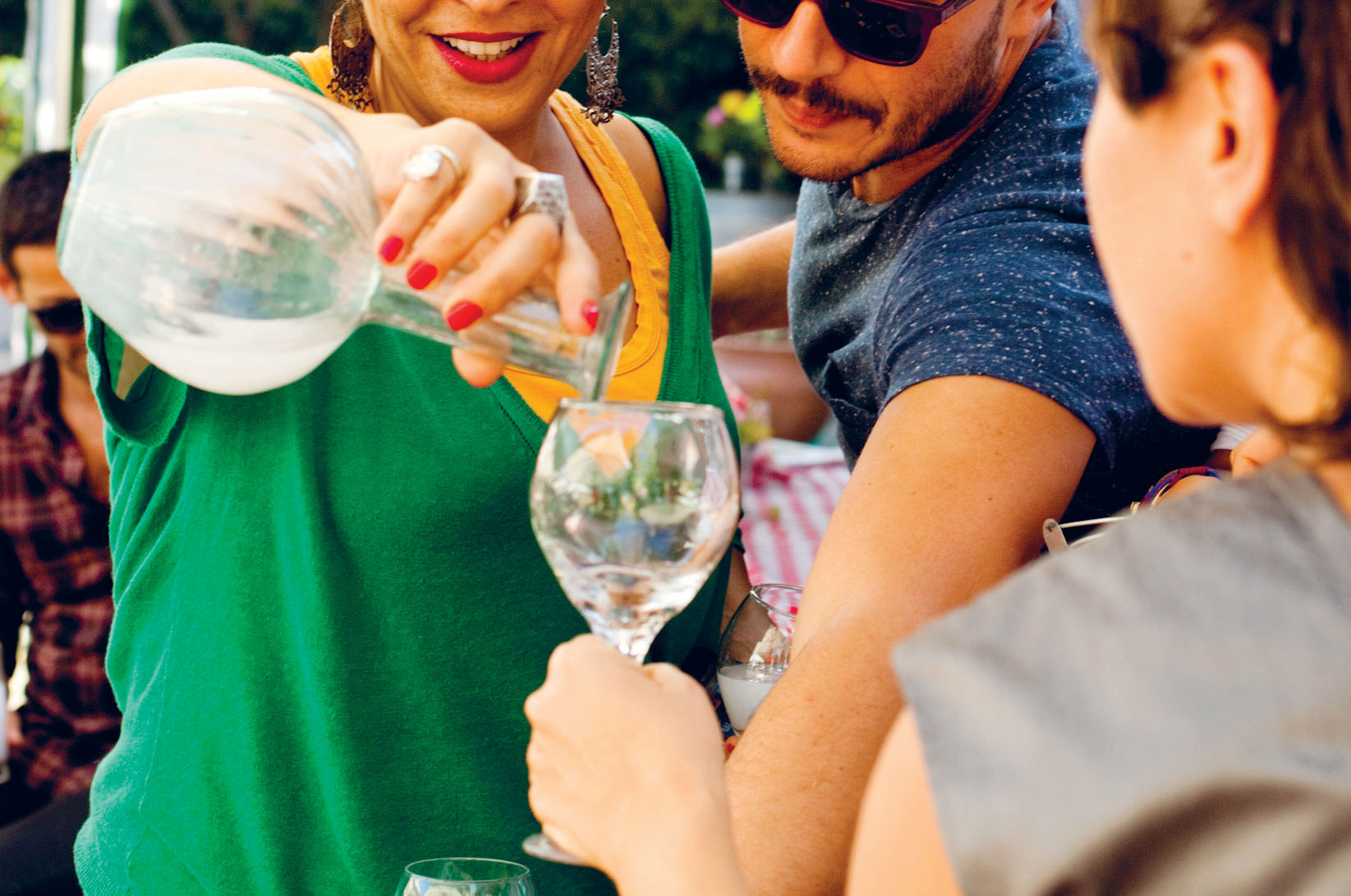
© Atalla/Courtesy of Domiane des Tourelles

SOUTH AFRICA
How to ask for a spirit without mixers? ‘Straight’ – English is widely used in South Africa
Signature spirit? Brandy
What to order with your spirits? Coke
Do: Beware South Africa’s ‘shooter’ culture, in which nights are punctuated by potent shots, including tequila, Jägermeister and Springbokkies (Amarula Cream and peppermint liqueur, reflecting the green-and-gold Springboks rugby top)
 Spirits have been produced at the southern tip of Africa for as long as colonials have sat on the veranda extolling the virtues of G&T’s quinine for combating malaria. Africa’s oldest distillery, the James Sedgwick Distillery, traces its whisky-making history back to the 19th century, when the eponymous British sea captain arrived in Cape Town by clipper.
Spirits have been produced at the southern tip of Africa for as long as colonials have sat on the veranda extolling the virtues of G&T’s quinine for combating malaria. Africa’s oldest distillery, the James Sedgwick Distillery, traces its whisky-making history back to the 19th century, when the eponymous British sea captain arrived in Cape Town by clipper.
Today, as with many aspects of South African life, the Rainbow Nation’s various racial and cultural groups have different liquor traditions and preferences. For Afrikaners, the descendants of the Boers who fought two wars against the gin-swigging Brits, only brandywyn (brandy) and coke will do. The classic homegrown brandy brand to enjoy with your braai (barbecue) is Klipdrift, aka ‘Klippie’, and for dessert there’s Amarula Cream, a bushveld Baileys made with marula fruit.
Dedicated liquor lovers can also seek out the Boer moonshine known as mampoer, a potent peach brandy that’s popular in northern farming towns; containing 50% to 80% alcohol, the drink is one of the strongest worldwide. It was named after the pugnacious 19th-century Pedi chief Mampuru by small-holders, who gained their land as a result of his conflicts with the colonial authorities. The Cape’s equivalent poison, clear brandy distilled from grapes, is known as witblits (‘white lightning’), but we recommend concentrating instead on the region’s burgeoning craft gin scene. Developing the traditional, juniper-dominant gins introduced by the Dutch and British, canny distillers are creating botanical infusions using the indigenous fynbos vegetation, part of the Unesco-protected Cape Floral Kingdom stretching roughly from Table Mountain to the Garden Route. Watering holes dedicated to ‘mother’s ruin’ abound in the Mother City, while Bascule Bar at the luxurious Cape Grace Hotel has one of the southern hemisphere’s largest whisky collections.
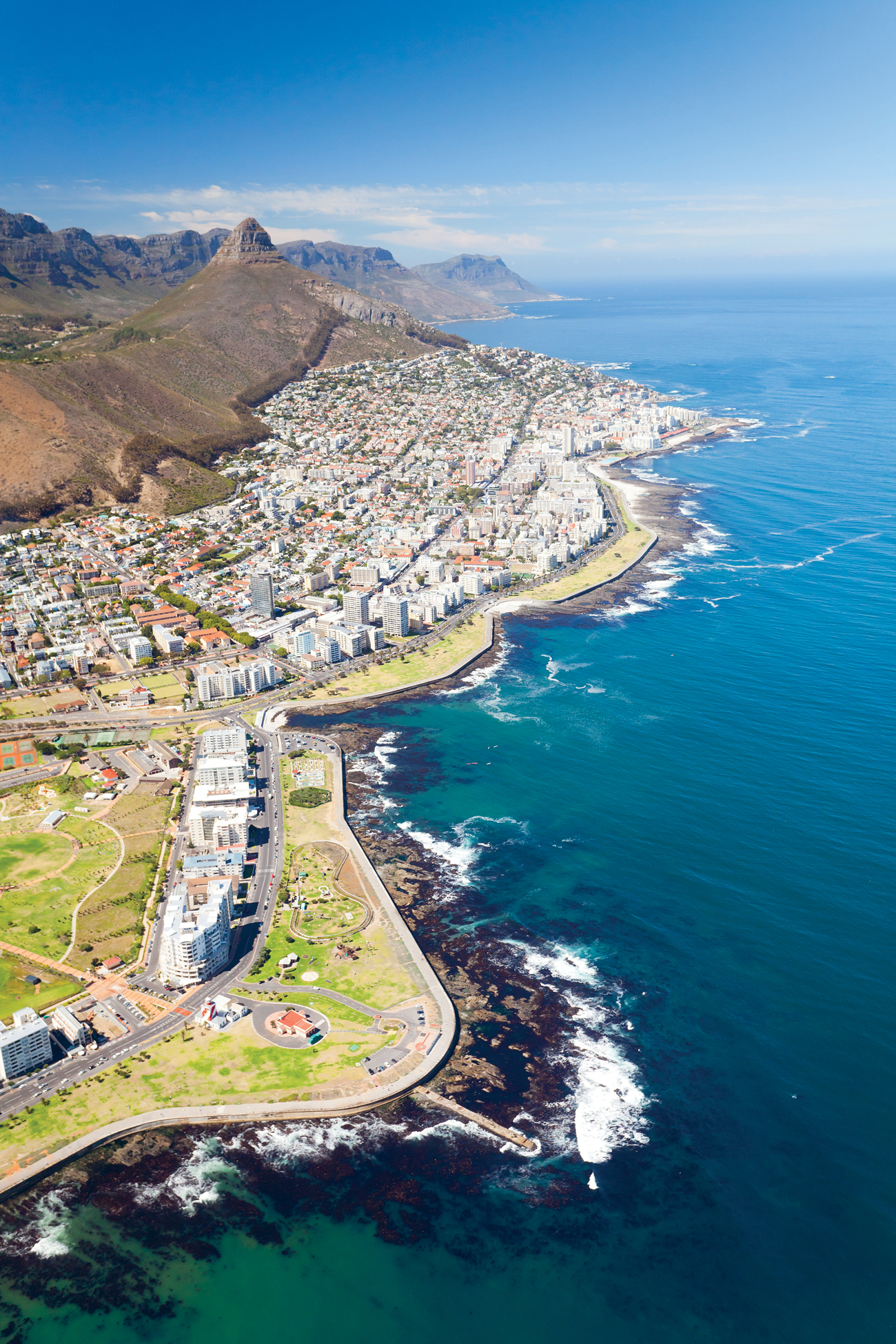
© michaeljung/Shutterstock
TIME ANCHOR DISTILLERY
7 Sivewright Ave, New Doornfontein, Johannesburg, Guateng;
www.timeanchor.co.za; +27 72 495 1983
◆ Distillery
◆ Shop
◆ Bar
◆ Transport
 Johannesburg’s first craft gin distillery is housed in a small warehouse on the edge of Maboneng, a vibrant, regenerated area of the city’s gritty downtown. Rather than tours, Time Anchor specialises in structured tasting events (check the website for dates). The main event is sampling the distillery’s colourful ‘Mirari Trio’ of gins, crafted from all-natural ingredients and handpicked botanicals. The Blue includes grains of paradise, from a peppery tasting plant native to West Africa, and cubeb pepper, native to Indonesia. Amber uses Boekenhout raw honey, the much-revered rooibos, and fynbos. The Pink gin, with damask rose, green cardamom and an infusion of natural rose water, is perfect in the Blackberry G&T, using Fentimans pink grapefruit tonic and blackberry G&T jam.
Johannesburg’s first craft gin distillery is housed in a small warehouse on the edge of Maboneng, a vibrant, regenerated area of the city’s gritty downtown. Rather than tours, Time Anchor specialises in structured tasting events (check the website for dates). The main event is sampling the distillery’s colourful ‘Mirari Trio’ of gins, crafted from all-natural ingredients and handpicked botanicals. The Blue includes grains of paradise, from a peppery tasting plant native to West Africa, and cubeb pepper, native to Indonesia. Amber uses Boekenhout raw honey, the much-revered rooibos, and fynbos. The Pink gin, with damask rose, green cardamom and an infusion of natural rose water, is perfect in the Blackberry G&T, using Fentimans pink grapefruit tonic and blackberry G&T jam.
THINGS TO DO NEARBY
Main Street Walks
Explore Maboneng – ‘place of light’ in Sotho – on an interactive tour with an in-the-know local, including a visit to the oldest traditional healers’ market in the city.
Market on Main
This buzzy Sunday food market has grown out of Maboneng’s first creative hub, Arts on Main, and is the go-to place for pan-African produce, as well as local design.
 BAR
BAR
WILD ABOUT WHISKY
506 Naledi Drive, Dullstroom, Mpumalanga;
www.wildaboutwhisky.com; +27 13 254 0066
◆ Shop
◆ Bar
 Dullstroom is not what you expect to find in sunny South Africa: this is trout-fishing country, as well as one of the country’s coldest towns, thanks to its location above 2000m on the Highveld plateau. Inspired by this bracing setting, Wild About Whisky offers the southern hemisphere’s largest whisky menu, featuring well over 1000 whiskies, 45 tutored tastings and a shop with 300 bottles.
Dullstroom is not what you expect to find in sunny South Africa: this is trout-fishing country, as well as one of the country’s coldest towns, thanks to its location above 2000m on the Highveld plateau. Inspired by this bracing setting, Wild About Whisky offers the southern hemisphere’s largest whisky menu, featuring well over 1000 whiskies, 45 tutored tastings and a shop with 300 bottles.
Whisky-worshipping staff, who tour the Scottish distilleries annually, guide you through tastings with themes such as Islay malts, American bourbons, 18-year-olds and ‘to peat or not to peat’. The tastings of six half-tots (15ml servings) also cover other spirits from craft gins to tequilas. Don’t miss educating your palate with tastings themed around the latest distilling trends, such as Scotch single malts without age statements.
THINGS TO DO NEARBY
Blyde River Canyon Nature Reserve
Rock formations and waterfalls punctuate a drive through the world’s third-largest canyon, where the Drakensberg Escarpment meets the Lowveld.
Dullstroom Bird of Prey & Rehabilitation Centre
Learn about raptor species and the dangers facing them, with flying displays involving peregrine falcons, kestrels, buzzards and black eagles.
HOPE ON HOPKINS
7 Hopkins St, Salt River, Cape Town
www.hopeonhopkins.co.za; +27 21 447 1950
◆ Tours
◆ Shop
◆ Transport
◆ Distillery
◆ Food
◆ Bar
 Pioneers of the South African gin revolution, Leigh Lisk and Lucy Beard opened Cape Town’s first artisan gin distillery with three stainless steel pot stills that enthusiasts can observe on Hope on Hopkins’ popular Saturday tour. In the small modern tasting room, Leigh and Lucy make suggestions on pairings and then let guests pick and mix their own gin, tonics and garnishes. Tasty snacks such as local charcuterie and spicy olives are also included.
Pioneers of the South African gin revolution, Leigh Lisk and Lucy Beard opened Cape Town’s first artisan gin distillery with three stainless steel pot stills that enthusiasts can observe on Hope on Hopkins’ popular Saturday tour. In the small modern tasting room, Leigh and Lucy make suggestions on pairings and then let guests pick and mix their own gin, tonics and garnishes. Tasty snacks such as local charcuterie and spicy olives are also included.
The duo’s gins are made with local malted barley and Table Mountain water. While they produce whimsical limited editions, such as pomegranate gin for summer, and a winter gin using sour figs and oranges; the bottle to take home is the Salt River Gin, made with wild rosemary, South African fynbos and the indigenous medicinal herbs buchu and kapokbos.
THINGS TO DO NEARBY
Neighbourgoods Market
Every Saturday, hundreds of fashion, food and wine stalls open around Woodstock’s Old Biscuit Mill – a paradise for eating, drinking and shopping.
www.neighbourgoodsmarket.co.za
Township Art Tour
Local artist Juma Mkwela takes small groups into sprawling Gugulethu township for a unique art tour visiting painters, vegetable gardens and a street-food canteen.
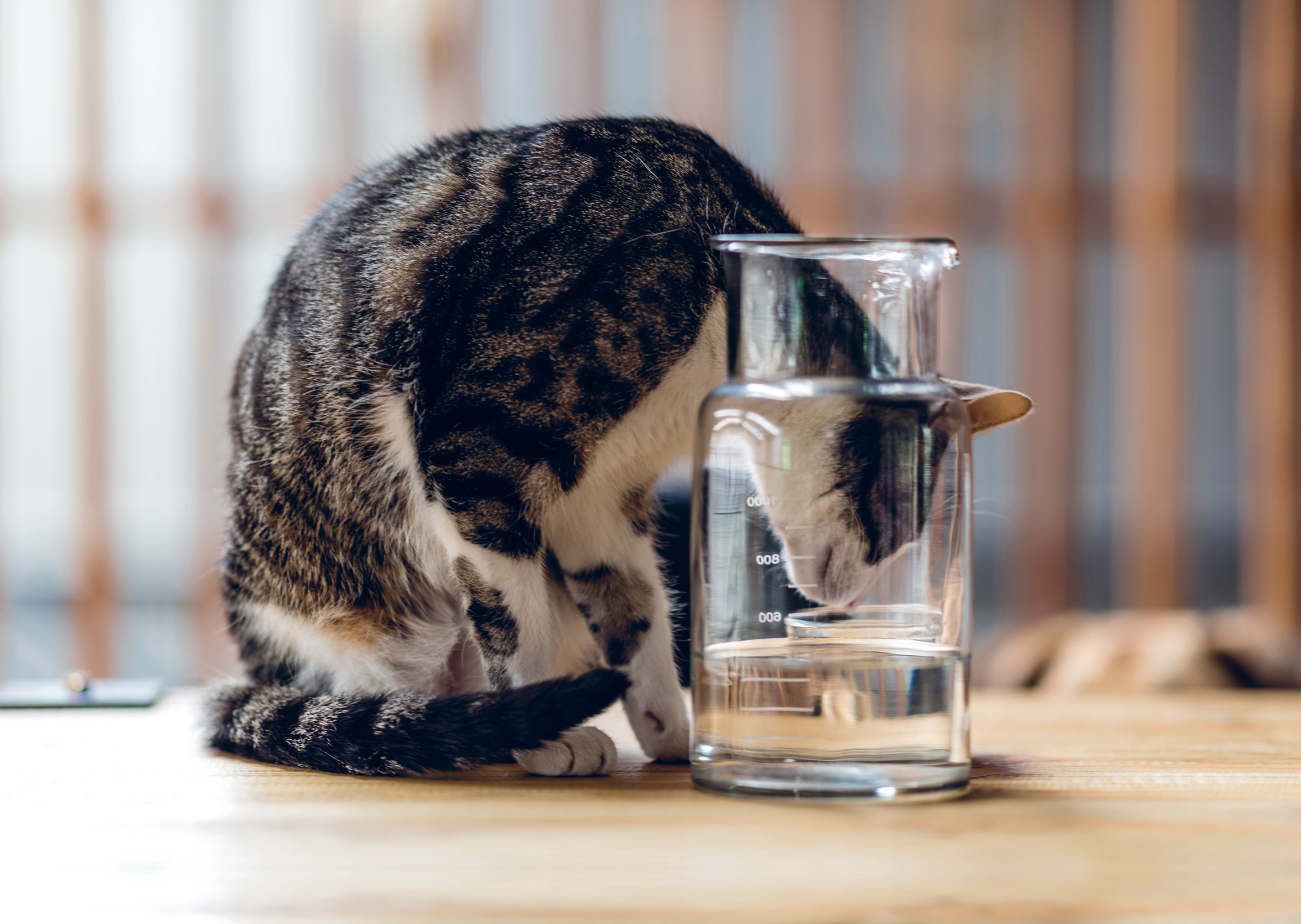
Courtesy HOpe on Hopkins
PIENAAR & SON
1 Roeland Terrace, City Bowl, Cape Town
www.pienaarandson.co.za; +27 21 461 4993
◆ Tours
◆ Shop
◆ Transport
◆ Distillery
◆ Bar
 Schalk Pienaar designed his own stills and had them made locally, using skills he honed during four decades working as a manufacturer of distilling equipment. His son Andre is the young gun master distiller, using the custom-designed kit to produce two gins and a vodka, made with local maize and sold in sleek Italian bottles.
Schalk Pienaar designed his own stills and had them made locally, using skills he honed during four decades working as a manufacturer of distilling equipment. His son Andre is the young gun master distiller, using the custom-designed kit to produce two gins and a vodka, made with local maize and sold in sleek Italian bottles.
Their small urban distillery has exposed brick walls and beams overlooking the shiny stills popping with pipes and valves, which can host tour-goers and also drop-in visitors wishing to sample. The dry English-style Empire Gin has refreshing hints of citrus, cucumber and pine; the Orient Gin is a must-try, with notes of vanilla, mandarin and ginger that pay homage to the maritime spice trade that influenced Cape Town in the 17th and 18th centuries.
THINGS TO DO NEARBY
The Book Lounge
A short stumble from Pienaar & Son is the city’s best independent bookshop, with a winning combo of knowledgeable staff, African novels and non-fiction, and regular events.
District Six Museum
The museum shows how this area, which used to be a multicultural neighbourhood, was razed under apartheid and its inhabitants forcibly relocated out of town.

courtesy ©Jack Mason /Pienaar & Sons
WOODSTOCK GIN COMPANY
399 Albert Rd, Woodstock, Cape Town
www.woodstockginco.co.za; +27 21 821 8208
◆ Food
◆ Distillery
◆ Tours
◆ Shop
◆ Bar
◆ Transport
 This micro-distillery in bohemian Woodstock produces arguably the most innovative range in South Africa. Master distiller Simon Von Witt uses Cape Town’s lush mountain vegetation – rose geranium, honeybush, wild sage and South Africa’s emblematic fynbos flower – to impart intriguing floral aromas. But what also singles out Woodstock’s signature Inception Gin is that it has two different labels – and flavours – depending on the base alcohol used to make it. The first (white label) uses a blend of local chenin and sauvignon grapes; the second (yellow label) uses a craft Weissbier base for a punchier, more caramelised spirit.
This micro-distillery in bohemian Woodstock produces arguably the most innovative range in South Africa. Master distiller Simon Von Witt uses Cape Town’s lush mountain vegetation – rose geranium, honeybush, wild sage and South Africa’s emblematic fynbos flower – to impart intriguing floral aromas. But what also singles out Woodstock’s signature Inception Gin is that it has two different labels – and flavours – depending on the base alcohol used to make it. The first (white label) uses a blend of local chenin and sauvignon grapes; the second (yellow label) uses a craft Weissbier base for a punchier, more caramelised spirit.
Woodstock’s most original creation is High Tea Gin, which features South Africa’s distinctive rooibos leaf, more well-known for making tea. Von Witt conducts tastings at tables facing a glass wall with the distillery’s pot stills and vats on the other side (also open to walk-in drinkers). His method is to lead tasters through all his gins neat, then get them to sample again using craft tonic waters with creative garnishes such as gooseberry and rosemary, cinnamon bark or orange peel.
THINGS TO DO NEARBY
Zeitz MOCAA
This revolutionary museum, dedicated to contemporary African art, is located in a stunning, immense 1920s concrete grain silo right on Cape Town’s harbour waterfront.
Woodstock Grill and Tap
The city’s best beer pub offers tours of its brewery, eight artisan ales, juicy steaks and healthy salads. Its latest innovation is craft gin and tonic on tap.
Biesmiellah
Order a spicy feast of Cape Malay dishes at this Bo-Kaap canteen. You’ll get to savour dishes such as bobotie and kingklip curry, which are influencing chefs all over the city.
Street Art
Graffiti artists have transformed Woodstock’s backstreets with murals. Wander between Albert and Victory, Barron and Essex streets to witness giant elephants, giraffes and gorillas.
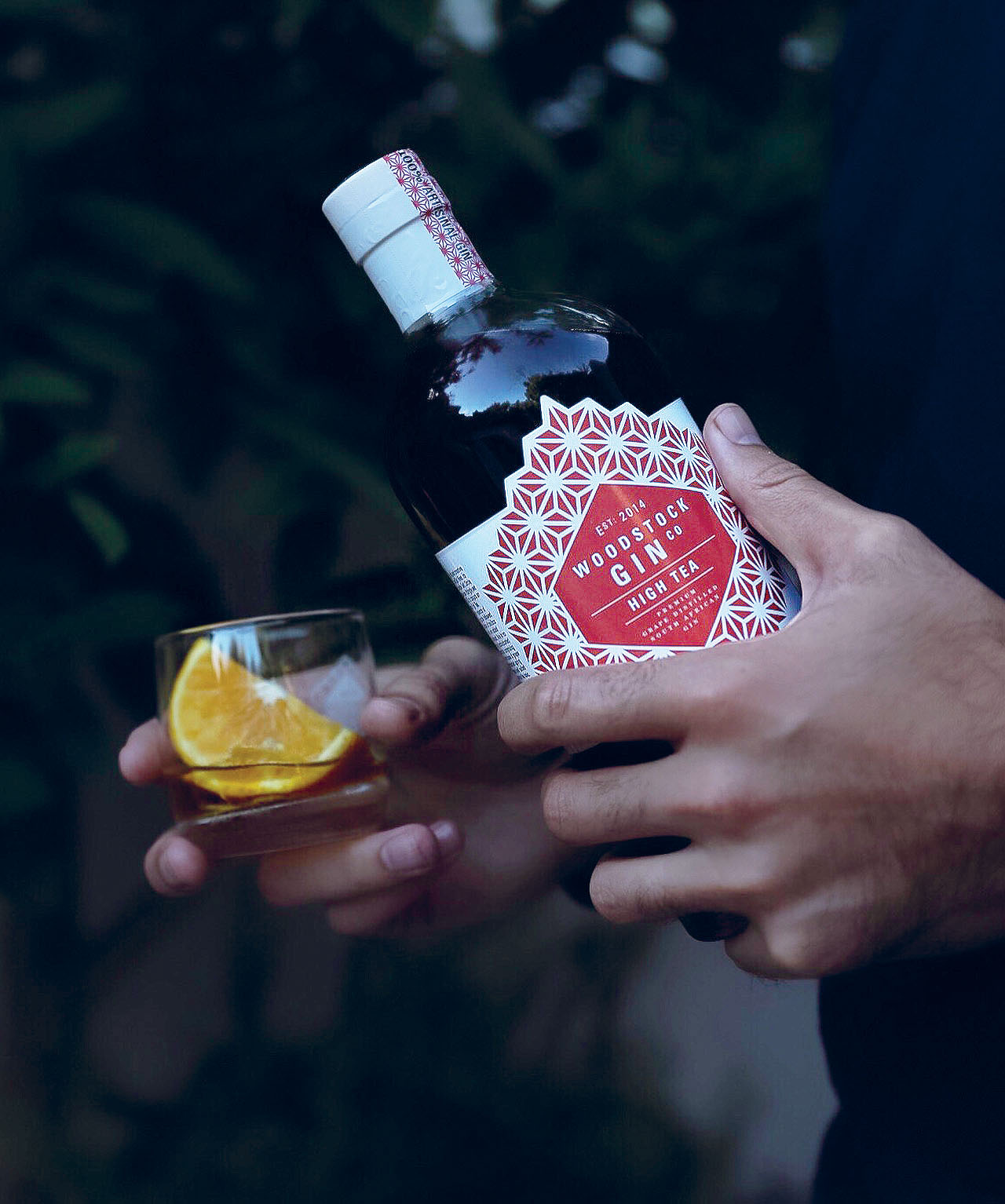
© Courtesy of Woodstock Gin
CAPE TOWN GIN & SPIRITS COMPANY
Cape Town Gin Hidden Door, Heritage Sq, cnr Shortmarket & Bree Sts;
www.capetowngincompany.com
◆ Shop
◆ Bar
◆ Transport
 This gin distillery takes its inspiration from the city at the foot of Table Mountain, and has a tasting room at Heritage Square – central Cape Town’s elegant complex of bars and restaurants, housed in Cape Dutch, Georgian and Victorian buildings. It has three handcrafted, small-batch spirits to taste: the Cape Town Classic Dry Gin remembers the Dutch and British colonials who brought gin to the Cape two centuries ago, when juniper berries were the predominant flavour; while the Cape Town Rooibos Red Gin, another winner at the 2017 World Drinks Awards, is infused with South Africa’s indigenous rooibos tea grown in the nearby Cederberg range. Don’t miss the equally colourful Cape Town Pink Lady Gin, a hibiscus- and rose-petal-infused tribute to the city’s very grand (and very pink) Mount Nelson Hotel.
This gin distillery takes its inspiration from the city at the foot of Table Mountain, and has a tasting room at Heritage Square – central Cape Town’s elegant complex of bars and restaurants, housed in Cape Dutch, Georgian and Victorian buildings. It has three handcrafted, small-batch spirits to taste: the Cape Town Classic Dry Gin remembers the Dutch and British colonials who brought gin to the Cape two centuries ago, when juniper berries were the predominant flavour; while the Cape Town Rooibos Red Gin, another winner at the 2017 World Drinks Awards, is infused with South Africa’s indigenous rooibos tea grown in the nearby Cederberg range. Don’t miss the equally colourful Cape Town Pink Lady Gin, a hibiscus- and rose-petal-infused tribute to the city’s very grand (and very pink) Mount Nelson Hotel.
THINGS TO DO NEARBY
Bree Street
You’ll find artisanal everything on this foodie thoroughfare, where hip establishments sell goodies from tapas to cocktails.
www.capetown.travel/visitors/eat-drink/bree-street
Mount Nelson Hotel
Liked the pink gin? Visit the pink lady herself, aka ‘the Nellie’, for a sumptuous high tea to remember, in leafy grounds that have hosted the likes of Queen Elizabeth.
DEEP SOUTH DISTILLERY
53 Heron Park, Wildevoelvlei Rd, Kommetjie, Western Cape;
www.deepsouthdistillery.co.za; +27 21 783 0129
◆ Distillery
◆ Tours
◆ Shop
◆ Bar
 Opened in 2017, this recent entrant to Cape Town’s craft-distillery scene is located in the southern section of the mountainous peninsula leading to Cape Point, Africa’s southwesternmost tip. City dwellers call this creative and alternative area ‘the lentil curtain’.
Opened in 2017, this recent entrant to Cape Town’s craft-distillery scene is located in the southern section of the mountainous peninsula leading to Cape Point, Africa’s southwesternmost tip. City dwellers call this creative and alternative area ‘the lentil curtain’.
Deep South’s small-batch gins use floral and herbal botanicals from the surrounding Cape Floral Region. Hidden away on an industrial park in the surf town of Kommetjie, the distillery’s main product is Cape Dry Gin, infused with juniper, honeybush and buchu; the latter two botanicals are types of endemic local fynbos vegetation, more commonly found in tea and brandy respectively. Call ahead to arrange a distillery tour and don’t miss tasting Deep South's second flagship tipple, Ruby Gin, with its ruby-red colour and floral flavours.
THINGS TO DO NEARBY
Chapman’s Peak Drive
Drive, cycle or walk the 5km-long ‘Chappies’, one of the world’s most beautiful coastal roads, with views over Hout Bay on the Cape Peninsula’s Atlantic side.
Boulders Penguin Colony
Across the Cape Peninsula on False Bay, boardwalks lead to the beaches and boulders frequented by a colony of some 3000 delightful waddling African penguins.
INVERROCHE
Old Riversdale Rd, Still Bay, Western Cape;
www.inverroche.com; +27 28 754 2442
◆ Distillery
◆ Tours
◆ Shop
◆ Bar
 This pioneer of South Africa’s craft gin scene was established in 2011 in a rugged coastal setting at the western end of the Garden Route by Lorna Scott and her son Rohan, who had tinkered for a few years on a copper pot-still known as ‘Mini Meg’ before graduating to the 1000-litre ‘Magnaminous Meg’. Their three gins reflect Inverroche’s location in the Cape Floral Kingdom, using a handful of the 9000-plus types of indigenous fynbos that exist in this Unesco-inscribed botanical region. The environment is high on this distillery’s agenda: by working with local botanists to find new ways of using the local flora in their spirits, the Scotts hope they will help protect the habitat by further stimulating a conservation economy in the broader community.
This pioneer of South Africa’s craft gin scene was established in 2011 in a rugged coastal setting at the western end of the Garden Route by Lorna Scott and her son Rohan, who had tinkered for a few years on a copper pot-still known as ‘Mini Meg’ before graduating to the 1000-litre ‘Magnaminous Meg’. Their three gins reflect Inverroche’s location in the Cape Floral Kingdom, using a handful of the 9000-plus types of indigenous fynbos that exist in this Unesco-inscribed botanical region. The environment is high on this distillery’s agenda: by working with local botanists to find new ways of using the local flora in their spirits, the Scotts hope they will help protect the habitat by further stimulating a conservation economy in the broader community.
The Inverroche Gin Classic is infused with fynbos harvested from limestone-rich lowland soils, giving it grassy juniper notes upfront, then assertive florals leading to a dry and spicy finish. The distillation process involves layering the fynbos in steam baskets within the wood-fired still, allowing the gently heated spirit vapour to extract the aromatic oils from the botanicals. The Inverroche Gin Verdant and Inverroche Gin Amber, infused with mountain and coastal fynbos respectively, gain their golden tints by undergoing this process twice. Don’t miss a tasting, distillery tour or the monthly Gin Sensorium and School, in which you make your own gin.
THINGS TO DO NEARBY
Mossel Bay
In this relatively undeveloped Garden Route hub, hit the beach, spot whales from land or water and learn about the 15th-century Portuguese explorers who passed by.
Swellendam
South Africa’s fourth-oldest settlement, established in 1743, sleepy Swellendam has several thatched Cape Dutch properties and a jail to explore.
Point of Human Origins
Long before they started making gin, humans were living at Pinnacle Point, as this Middle Stone Age archaeological cave site shows. Guided tours explore the coastal cave.
De Hoop Nature Reserve
This stunning fynbos-clad coastal reserve is good for hiking and mountain biking. Its five-day Whale Trail offers sightings of ostriches, Cape mountain zebras and, of course, whales.

© Courtesy of Inverroche
JAMES SEDGWICK DISTILLERY
79 Stokery Rd, Wellington, Western Cape;
www.threeshipswhisky.co.za: +27 72 415 3440
◆ Distillery
◆ Tours
◆ Shop
 Africa’s oldest distillery, established in the Cape Winelands town of Wellington in 1886, unusually produces both malt and grain whiskies on the same site. Most are under the Three Ships banner, but Bain’s Cape Mountain Whisky (the world’s only 100% South African maize whisky) was named World’s Best Grain Whisky at the World Whiskies Awards 2018.
Africa’s oldest distillery, established in the Cape Winelands town of Wellington in 1886, unusually produces both malt and grain whiskies on the same site. Most are under the Three Ships banner, but Bain’s Cape Mountain Whisky (the world’s only 100% South African maize whisky) was named World’s Best Grain Whisky at the World Whiskies Awards 2018.
Tours of the distillery cover the whisky-making process from milling the raw ingredients through to maturation and blending, followed by a tasting that pairs apple crisps, smoked beef, chocolate mousse and more with the house single malts and blends. The tasting room is a knockout, overlooked by a few of the site’s 150,000 whisky casks. Creating your own 50ml blend in the micro-distillery is a highlight.
THINGS TO DO NEARBY
Bainskloof Pass
Andrew Geddes Bain, the 19th-century engineer and namesake of Sedgwick’s single-grain whisky, built this epic mountain pass, which you can ascend from Wellington on Route 301.
Wellington wineries
Wellington has a wine route of more than a dozen farms, where you can taste, dine and sleep. Try, for example, a gourmet pie and wine pairing at Imbuko.
www.wellington.co.za/wellington-wine-farms

© Shutterstock / Harry Beugelink